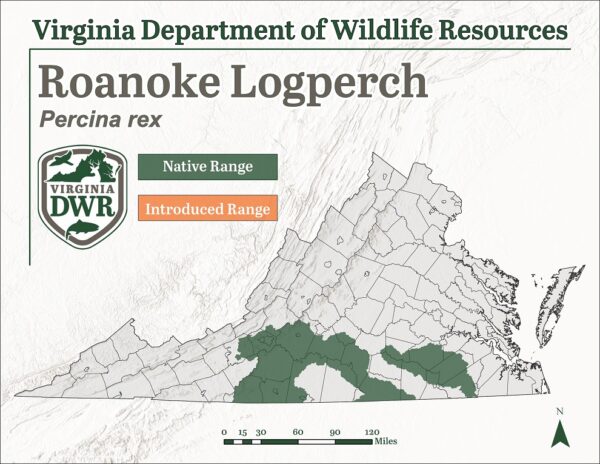Roanoke Logperch habitat. ©Michael Pinder - Virginia DWR
Roanoke Logperch among the stream cobble. ©Ryan Haggerty - U.S. Fish and Wildlife Service
Fact File
Scientific Name: Percina rex
Classification: Fish, Order Perciformes, Family Percidae
Conservation Status:
- Federally Endangered in the U.S.
- State Endangered in Virginia
- SGCN Tier IIa: The Virginia 2015 Wildlife Action Plan lists Roanoke Logperch as a Species of Greatest Conservation Need (SGCN) in Tier II, with a conservation opportunity ranking of "a"
Size: Up to 6 inches
Life Span: Average 5-6 years
Identifying Characteristics
- Moderately long, pig-like snout
- Round or vertically elongate lateral blotches on the body
- Strongly patterned fins
- Emarginate or truncated caudal (tail) fin
Distribution
Roanoke Logperch populations within Virginia are endemic to the Roanoke and Chowan watersheds, located in the southern portion of the state.

Feeding
Roanoke Logperch consume an array of benthic macroinvertebrates. In addition to opportunistic feeding, Roanoke Logperch will actively hunt for prey items by turning over rocks and other substrate materials.
Video Source: ©Madison Cogar – Virginia DWR
Habitat
Like other darters, Roanoke Logperch are benthic (bottom-dwelling), and specialize in using the interstitial spaces between cobble for protective cover and opportunistic feeding. Roanoke Logperch require clean-flowing water and are considered an indicator species of overall watershed health, as their required habitat is degraded by erosion and siltation.
Video Source: ©Madison Cogar – Virginia DWR
Special Considerations
It is illegal to target Roanoke Logperch by angling. The Roanoke Logperch is listed as an endangered species under federal and Virginia law. It is a violation of state and federal law to harass, harm, or take any Roanoke Logperch.
For the definitions of take, harass, and harm, see 4 VAC 15-20-140.
Last updated: May 14, 2024
The Virginia Department of Wildlife Resources Species Profile Database serves as a repository of information for Virginia’s fish and wildlife species. The database is managed and curated by the Wildlife Information and Environmental Services (WIES) program. Species profile data, distribution information, and photography is generated by the Virginia Department of Wildlife Resources, State and Federal agencies, Collection Permittees, and other trusted partners. This product is not suitable for legal, engineering, or surveying use. The Virginia Department of Wildlife Resources does not accept responsibility for any missing data, inaccuracies, or other errors which may exist. In accordance with the terms of service for this product, you agree to this disclaimer.

